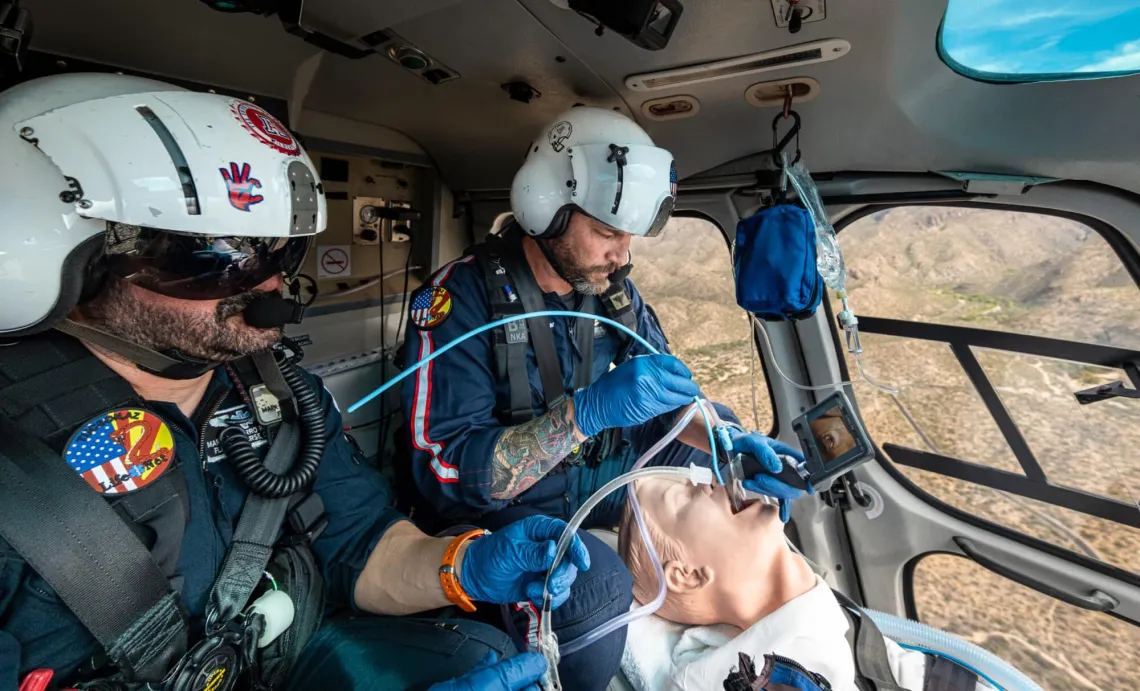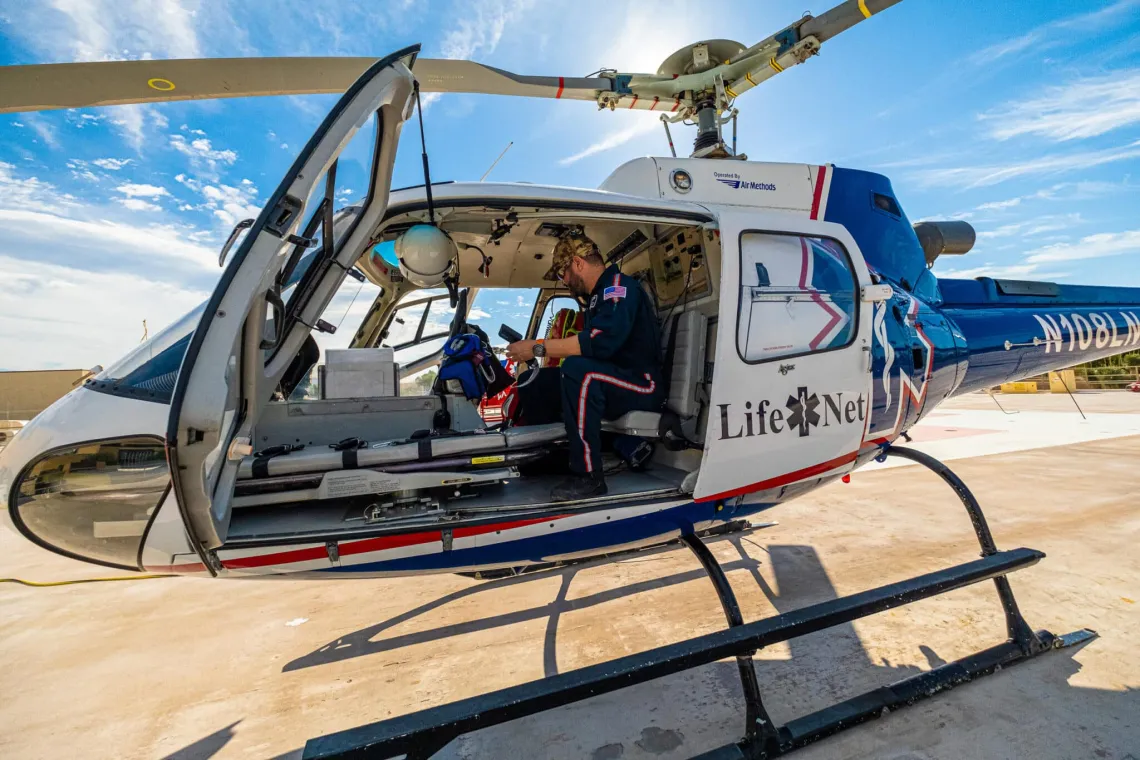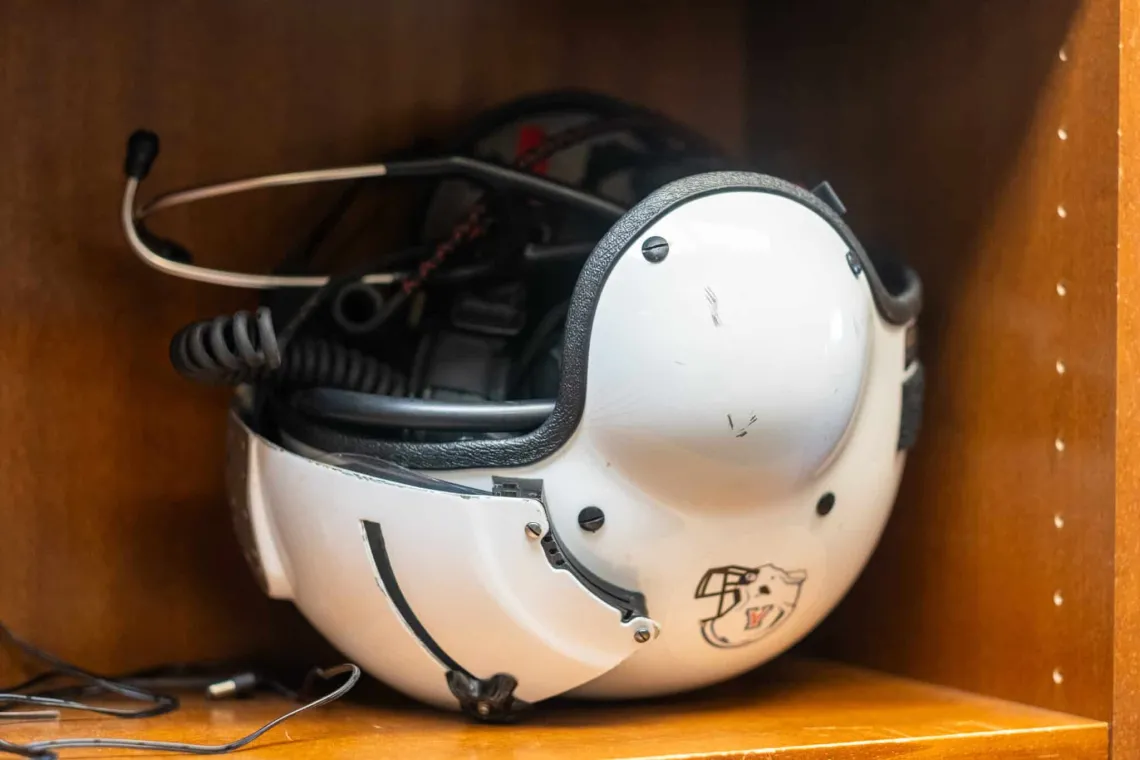As Rural Hospitals Disappear, Air Ambulances Struggle to Fill the Gap
Air ambulances are now a lifeline for many rural communities. But there is no guarantee they'll stick around.

AirMethods flight nurse Mark Navarro, left, and flight paramedic Aaron Rodgers practice intubating a dummy during a demo flight in Tucson on Sept. 28, 2023. (Michael McKisson, Arizona Luminaria)
This story was originally published by Barn Raiser, your independent source for rural and small town news.
https://barnraisingmedia.com/as-rural-hospitals-disappear-air-ambulance…
This story was supported by the journalism nonprofit the Economic Hardship Reporting Project, and produced in collaboration with Arizona Luminaria, a nonprofit newsroom dedicated to local, community-centered journalism.
“They said I tried to keep the bike up,” says Dan McKeaney, 59, of Las Vegas, Nevada. His voice grows quiet, choked with emotion, thinking of the day he and his wife, Jeri, almost lost their lives. A veteran of Desert Storm, Dan and his wife were on a veterans’ motorcycle ride headed for Bagdad, Arizona last year when their bike suddenly blew a tire. “Once we went down, I lost memory of it,” Dan says.
The crash happened on a remote section of highway near Wikieup, Arizona, an unincorporated community about halfway between Phoenix and Las Vegas. McKeaney and his wife sustained several life-threatening injuries: Jeri suffered severe facial lacerations and a major concussion that caused her to lose consciousness; Dan had multiple fractured ribs, a collapsed lung, a bruised heart, a lacerated spleen, a torn meniscus and a high-grade concussion. Firefighters from about 40 miles away in Pinion Pines, an unincorporated community in Mohave County, Arizona, were able to stabilize Dan and Jeri, keeping them alive until an air ambulance team from Air Methods arrived.
Air Methods crews sprang into action, putting Dan in a helicopter bound for Las Vegas and Jeri in a traditional ground ambulance operated by another company headed to a hospital in Kingman, Arizona. When they learned that the Kingman hospital lacked the capacity to treat Jeri’s injuries, Air Methods crews airlifted her to a hospital in Las Vegas too.
“They went to extraordinary means to save my life,” Dan says, including performing a needle decompression—sticking a needle into the chest to release air from the pleural cavity—in the field. His injuries were so severe that he stayed in a medically induced coma in Las Vegas for three months. If an air ambulance hadn’t arrived on the scene, Dan is certain that he wouldn’t be alive.
Filling In the Cracks
In recent years, air ambulances have become a lifeline for many rural communities, even in cases of non-severe injuries.
Some of this demand is inevitable. When cars collide on a rural stretch of road or a hiker collapses from dehydration, an air ambulance can mean the difference between life and death. But in the past decade, first responders have noticed an uptick in demand for their services as rural hospitals nationwide face an unfolding crisis, increasingly terminating services or shutting down altogether.
According to a report by the American Medical Association, between 2010 and 2021, at least 136 rural hospitals shuttered completely, with a record 19 closures in 2020 alone. Of the remaining hospitals, nearly half are operating with negative profit margins, while a large portion of the others face significant financial strain. An estimated 200 hospitals nationwideare considered at risk of immediate closure this year, with 3 hospitals in Arizona — one-fifth of all hospitals in the state — in danger of shuttering. Since 2005, four rural Arizona hospitals have closed, and the only hospital in Green Valley — a retirement community in Southern Arizona — closed suddenly in 2022. According to data from the Cecil G. Sheps Center for Health Services Research at the University of North Carolina, so far 15 rural hospitals across the nation have closed in 2023.
The situation for rural hospitals improved somewhat during the COVID-19 pandemic, when emergency federal aid helped bolster struggling facilities. As pandemic-era policies wind down, a mix of complex factors such as the aging of the rural population, staffing shortages, increased drug and supply costs and low reimbursement rates have combined to produce a rural healthcare crisis. As a result, emergency services like air ambulances, often run by private equity companies looking to turn a profit, are left to fill the gaps in America’s deteriorating rural healthcare infrastructure.
As a result, air ambulance flight crews, such as those at Air Methods, a private company based in Colorado, report spending a growing proportion of their time transferring patients from under-resourced rural hospitals to far-away cities where they can receive the level of care they need. Once they leave the hospital, it’s up to patients to find their own way home.
Jennifer Park, 50, is an Air Methods flight nurse based in Parker, Arizona, a town near the California border. “There’s an aging population that just doesn’t have access to the resources they need,” says Park. “The vast majority of the transports we do are not what you would consider super acute, or life or death, but people who need to get to a resource in a timely fashion and just have no other way to get there.”
Meanwhile, the rural hospitals left standing are often forced to eliminate critical services to cut costs. When rural hospitals downsize, prenatal, natal, and neonatal services are often the first to go. Over the past decade, nearly 200 rural hospitals have stopped delivering babies. Across the country, fewer than half of all rural hospitals now offer labor and delivery services. The resulting “maternity care deserts” particularly effect women in low-income, minority and Native American communities, where the risk of dying of pregnancy-related complications is three times as high as in predominately white communities.
When critical services are far away and patients are left in the lurch, air ambulances often provide the missing link. Park recalls a case last year where a woman gave birth prematurely at a small rural hospital in western Arizona. The closest neonatal team was more than six hours away by ground. Park and her team had to create an ad-hoc mobile NICU unit in their helicopter — which wasn’t outfitted for that purpose — and transport the infant to a specialized facility. They were able to transport the infant safely in under two hours. Without recourse to an air ambulance, the infant would likely not have survived.
Obstetrics are just the tip of the iceberg. While air ambulance crew members say they are grateful for the opportunity to serve, many have raised concerns that the nation’s rural healthcare infrastructure is being whittled away, and they’re seeing the effects firsthand. “It’s primary care, it’s mental health, it’s specialty services,” says Park, citing all the services to which rural communities are losing access. “It’s been hard for everybody, and there just doesn’t seem to be an end in sight.”
Complications In the Field
Nestled amid white waterfalls, turquoise pools and towering red rock formations within the Grand Canyon, Supai, Arizona, is considered the most remote community in the contiguous United States and the capital of the Havasupai Indian Reservation. There are only three ways to get in or out: on foot, by mule or by helicopter.
Tatyana Logan, 31, a medic for Air Methods, visits Supai roughly once a week. For minor injuries and illnesses, Supai has a clinic, staffed by one physician who serves approximately 1,110 patients, almost all members of the Havasupai tribe. For anything more serious, the clinic calls Air Methods to send help by helicopter. “If it can’t be handled in that small clinic,” she says, “we’ll take them to Flagstaff.”

Air Methods flight nurse Mark Navarro preparing for a demo flight in Tucson, Ariz. on Sept. 28, 2023. The base at Tucson Medical Center serves as a training station for new crew members. (Michael McKisson, Arizona Luminaria)
The deterioration of rural healthcare has hiked up the demand for air ambulances, and workers can feel the difference. “If the rural hospital doesn’t have the staff,” says Logan, “or they don’t have the money to pay for a GI specialist or having neuro on-call there, we’re flying in and taking those patients out.” As a result, Logan says her call volume has greatly increased. “I honestly don’t mind it. I love being busy,” she adds. “But it does take a toll on us, physically and mentally.”
“Trying to find a bed is always tough,” says former Air Methods pilot Daniel Griffith, 37, noting that the overburdened hospital system in rural Arizona is put under further strain by the yearly influx of retirees during the winter months. Recently, he says, it’s gotten even tougher. “You started getting really weird flight requests,” Griffith says. “You normally go from northern Arizona into Phoenix, but now all of a sudden they want you to do a two-and-a-half-hour flight to some other state, because that was the only bed available in the entire region.”
Air Methods flight nurse Nicholas Naumoff, 28, describes a precarious balancing act between on-scene emergencies and inter-hospital transfers. Naumoff is based in Bullhead City, Arizona, located directly on the border with Nevada and just miles from the border with California. His flight crew often responds to outdoor recreation emergencies and accidents in the desert. Naumoff cites a recent example of each: a boat explosion on a nearby lake, and an incident where a woman walking her dog on open-range ranchland was gored by a bull.
The job is demanding even without a rural healthcare crisis unfolding in the background. Fort Mohave, which is within the purview of Naumoff’s Air Methods crew, is the second-hottest place in the country after nearby Death Valley. Naumoff says the crew often works in 120-degree temperatures. In addition to the heat, the job comes with an irregular sleep schedule. Calls sometimes come in the middle of the night, requiring flight nurses to transition from fully asleep to saving someone’s life in a matter of minutes.
On top of these ordinary stressors, Naumoff says that it’s tough serving as a catch-all support in a medically underserved environment. In an urban or suburban environment, Naumoff says many of the patients he treats would typically go by ground ambulance.
“It can be challenging when we feel like we’re flying patients that could be better served,” says Naumoff. “There’s a little bit of a mental battle at 2 a.m. when you’re picking up a patient who’s not super critical and could have gone by ground if ground was available, or if the hospitals down here had better services.”

A flight helmet sits on a shelf in the Air Methods base in Tucson, Ariz., while the flight crew waits for their next call. (Michael McKisson, Arizona Luminaria)
Naumoff says that he also sometimes has to spend critical moments allaying patients’ concerns about medical costs. In recent years, the news has been filled with stories of people getting slapped with $50,000 bills for air ambulance rides that insurance companies refused to pay. The No Surprises Act of 2022 prohibited surprise billing for out-of-network air ambulance rides, a prohibition that does not yet extend to ground transport. But the implementation of the bill has been, as Senator Michael Bennett (D-Colo.) put it, “a big mess.” The existing provisions have had a positive effect, but loopholes, lawsuits and confusion abound.
“They will not get a huge bill from us,” clarifies Air Methods account executive Valerie Yevzerova, confirming the end of surprise billing in air ambulance rides. Air ambulance companies must give patients honest estimates of their charges before providing services. They can also no longer “balance bill” patients, the practice of charging patients for the remainder of what their insurance doesn’t cover. Air ambulance companies are now compelled to go through an Independent Dispute Resolution process if they disagree with insurers on prices.
As a result, the bills are getting smaller and more predictable. However, that information has been slow to reach consumers, and many still pay an unnecessary membership fee to air ambulance providers in order to avoid surprise bills that they don’t realize have been phased out.
The No Surprises Act also requires air ambulance providers, insurance companies and employer-based health plans to submit data about air ambulance services to federal regulators. This year, the Centers for Medicare and Medicaid Services (CMS) released a new webpage to Air Ambulance Collection Data that will be used to develop a public record on air ambulance services.
Surprise billing aside, there are still deductibles and other costs for rural residents to consider. Costs like these can be a huge blow for patients who live in poverty. While the No Surprises Act of 2022 contains provisions that protect uninsured people, getting an air ambulance ride without health insurance can still be costly. Yevzerova cites Air Methods’ patient advocacy program, which works with patients to set up repayment plans. But the details of billing and repayment can be tough for crew members to explain in the field.
“I’ve run into, even recently and within the last couple weeks, patients or family members that are very concerned about cost,” Naumoff says. In some cases, they’re willing to risk their physical health to avoid the cost. “We have had patients end up refusing,” he says, including cases “that are really critical.”
The same process is often at play, albeit in far less dramatic form, for years leading up to the moment that an air ambulance is called. Rural populations are disproportionately likely to delay and avoid healthcare. Cost and distance are two major reasons, and are often linked together, as seeking healthcare far from home comes with transportation and possibly lodging costs, as well as potentially unpaid time off work.
Park emphasizes that the trouble usually starts long before crew members arrive because of a lack of preventative medicine and access to basic services. “It’s not just acute care,” she says. “A lot of these patients are sicker at home without resources.” Park says that rural residents are often in far worse shape than they should be.
Logan attributes much of the poor health she encounters to rural poverty. “That contributes to health problems later on down the line,” she says.
Fighting Fire with Fire
As rural hospital infrastructure undergoes death by a thousand cuts, air ambulances have emerged as a crucial lifeline for many rural people. But there’s a problem: they’re not guaranteed to stick around, either.
Private air ambulance companies only open and operate bases and pay flight crews if executives feel certain that those activities will turn a profit. If an area becomes unprofitable—for example, if old age and low income push too many people in a region onto Medicare and Medicaid, which offer worse reimbursement rates than private insurance—then there’s nothing stopping the air ambulance companies from pulling out too. Indeed, since the passage of the No Surprises Act of 2022 the United States has seen a trend of air ambulance bases closing down, including Air Methods bases. (In 2022, Native Air, an Air Methods subsidiary, opened a new base in Show Low, Navajo County to provide coverage to northeastern Arizona).
Air ambulance base closures are a disturbing mirror of rural hospital closures and reductions, a symmetry that points to a glaring flaw in the system. Rural hospitals are also primarily run by private for-profit companies, including over a hundred rural hospitals run by private-equity firms. Profit-driven private companies have shown little reluctance to shutter hospital doors and can’t be relied on to provide transport services forever. If they’re not making enough money, they can just shut down, leaving residents truly without options. But for many rural residents, they continue to offer a crucial lifeline in a broken system.
If an air ambulance hadn’t arrived on the scene of the McKeaneys’ motorcycle crash near Wikiup, Dan is certain that he wouldn’t be alive.
Dan likens the rural healthcare landscape to a war zone. “It’s like a battlefield scenario,” he says, drawing upon his experience as a US Navy Hospital Corpsman in Iraq. In combat, “Troops come off the front line and go to a battalion aid station where they can get stable” and be treated with proper equipment out of harm’s way. The rural healthcare transport system is “the same philosophy, just in a more civilized environment than combat.”

